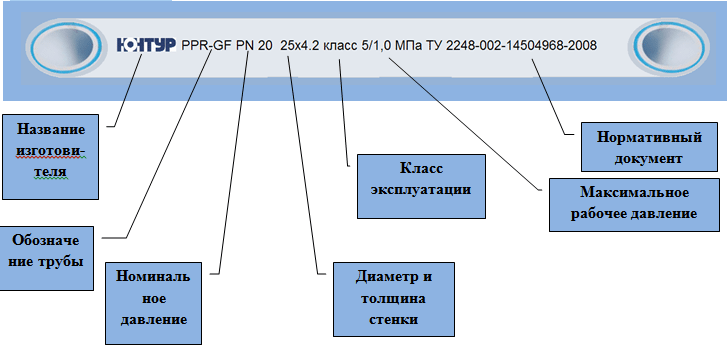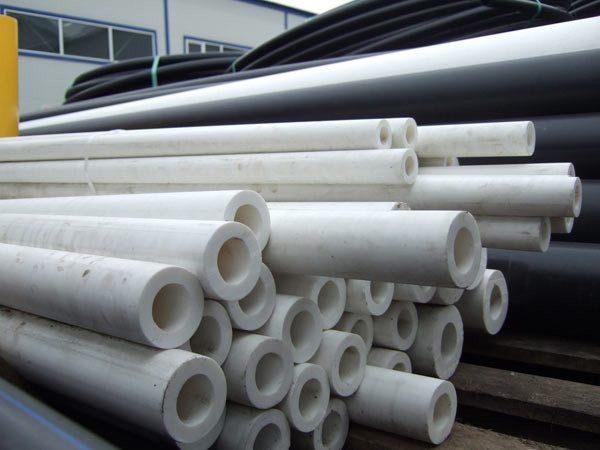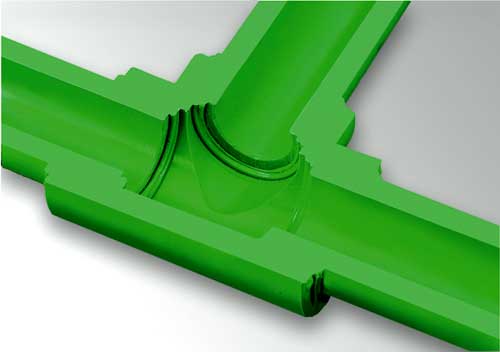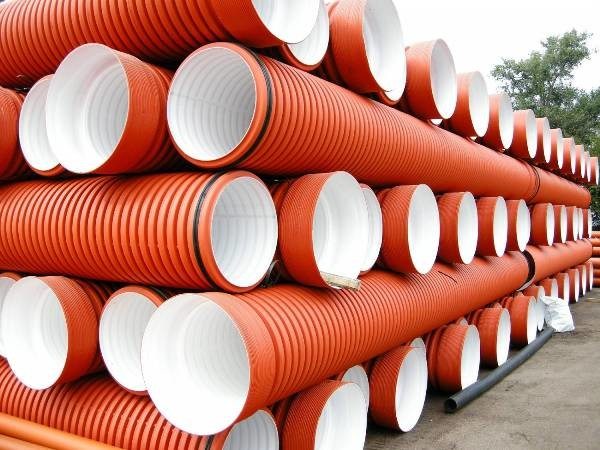Modification, marking and dimensions of polypropylene pipes
Over time, gradually, but surely, water supply and heating systems from metal are switching to polymers. It is noteworthy that the dimensions of polypropylene pipes are calculated in mm, and not in inches, as was done earlier (you can calculate in any unit, but the documentation is created in the metric system).
It was not for nothing that we mentioned PPR, since we will talk about it, that is, about modifications, markings and sizes that are used to transport liquids of different temperatures. If you are interested, then more information is below. And besides, you will see the video in this article, which will clearly demonstrate our topic.
PPR
Marking of polypropylene pipes

This is how PPR polypropylene are marked - pipe 25 mm and other sections
- The most popular products of this type are labeled PPR, as can be seen in the photo above, and this is all due to their very high heat resistance - such products are used for cold and hot water supply, as well as heating systems. Be that as it may, in any case, the first letters of the abbreviation will be PP.
But you can see PPH or PP-1, which means that the product is made of homopolymer (first generation product for cold water). You can also see the symbols PPB, which indicates the possibility of application for hot water and heating. - The PN symbols indicate the nominal pressure in bar. For example, if PPR - polypropylene - a pipe is 110 mm and other diameters are designated as PN20, then its working pressure is 20 bar, which is equal to 2 MPa or 20.4 kg / cm 2. Among all the symbols in this case, four categories can be distinguished - these are PN10, PN16, PN20 and PN25.
Moreover, the first two are made with a homogeneous wall, and the last two have a reinforcing layer in the middle or closer to the surface, which is made of fiberglass or aluminum foil. - In addition to the main data, the marking also indicates auxiliary data, such as the name of the manufacturer, class, outer diameter and wall thickness, the regulatory document of this product.
Note. It should be noted that PN10 and PN19 are produced without a reinforcing layer, which serves not to increase the resistance to internal pressure, but to protect against PPR deformation when heated.
Geometric parameters
| Rated pressure | Marking | Outer diameter (mm) | Wall thickness (mm) | Inner diameter (mm) |
| PN10 | 20x1.9 | 20 | 1,9 | 16,2 |
| 25×2.3 | 25 | 2,3 | 20,4 | |
| 32×3.0 | 32 | 3,0 | 26,0 | |
| 40×3.7 | 40 | 3,7 | 32,6 | |
| 50×4.6 | 50 | 4,6 | 40,8 | |
| 63×5.8 | 63 | 5,8 | 51,4 | |
| 75×6.9 | 75 | 6,9 | 61,2 | |
| 90×8.2 | 90 | 8,2 | 73,6 | |
| 110×10 | 110 | 10 | 90,0 | |
| PN20 | 16×2.7 | 16 | 1,6 | 10,6 |
| 20×3.4 | 20 | 3,4 | 13,2 | |
| 25×4.2 | 25 | 4,2 | 16,6 | |
| 32×5.4 | 32 | 5,4 | 21,2 | |
| 40×6.7 | 40 | 6,7 | 26,6 | |
| 50×8.4 | 50 | 8,4 | 33,2 | |
| 63×10.5 | 63 | 10,5 | 42,0 | |
| 75×12.5 | 75 | 12,5 | 50,0 | |
| 90×15.0 | 90 | 15 | 60,0 | |
| PN25 | D, mm | D1, mm | D2, mm | S, mm |
| 20 | 13,2 | 21,2 | 4,0 | |
| 25 | 16,6 | 26,2 | 4,8 | |
| 32 | 21,2 | 33,2 | 6,0 | |
| 40 | 26,6 | 41,4 | 7,4 | |
| 50 | 33,2 | 52,5 | 9,1 | |
| 63 | 42,0 | 65,9 | 11,3 | |
| 75 | 50,0 | 77,9 | 13,3 |
Table of sizes of polypropylene pipes PN10, PN20 and PN25

Pay attention to the table and you will see how the geometric parameters change depending on the nominal pressure with the same outer section.
For example, a 20 mm polypropylene pipe, here:
- PN10 will have an internal diameter of 16.2 mm, a wall of 1.9 mm;
- PN20 - inner diameter 13.2 mm, wall - 3.4 mm;
- PN25 - inner diameter 13.2, wall - 4.0 mm, but here the outer section is already slightly increased - in this case it turns out to be 21.2 mm.
The geometric proportions of other sections also change in the same way, for example, 32 mm polypropylene pipes:
- PN10 will have an internal diameter of 26.0 mm, a wall of 3.0 mm;
- PN20 - inner diameter 21.2 mm, wall - 5.4 mm;
- PN25 inner diameter 21.2 mm, wall - 6.0 mm.
And again, PN25 will turn out to be a little thicker than the nominal section - it will no longer be 32 mm, but 33.2 mm.

Note. Taking into account the fact that the reinforcing layer of aluminum foil is not in the middle of the wall, but closer to the surface, and the PN25 section slightly exceeds the conventional one, before welding products with a coupling, the instruction obliges to clean the soldering place from the top layer of PPR and foil.
It will be extremely difficult to carry out such a procedure with a knife, therefore, in such cases, a special shaver of a certain diameter is used.
| Section (mm) | Weld seat depth (mm) | Heating time (sec) | Cooling time (sec) |
| 20 | 14 to 17 | 5-6 | 2-3 |
| 25 | 15 to 19 | 6-7 | 3-4 |
| 32 | 16 to 22 | 8-9 | 4-5 |
| 40 | 18 to 24 | 12-13 | 5-6 |
| 50 | 20 to 27 | 18-19 | 6-7 |
| 63 | 24 to 30 | 24-25 | 7-8 |
| 75 | 26 to 32 | 30-31 | 8-9 |
| 90 | 29 to 35 | 40-41 | 9-10 |
Soldering depth and time depending on dimensions
As you understand, when installing PPR, polypropylene - a pipe of 50 mm, 32 mm or with other parameters, must be welded for joining through fittings. But a certain section of the product also implies a certain depth of planting its end into the fitting.
Also, the retention time of parts during welding and after it - during solidification depends on the section. You can determine the insertion depth of the product into the fitting and its holding time using the upper table.

Welding parameters are extremely important for each size, because if PPR polypropylene - a pipe of 16 mm nominal diameter is pushed into the fitting more than it should be, then due to the flattening of the walls, the permeability will decrease, or the passage will clog altogether. If this happens in a tee or quad, then the end will simply block the perpendicular outlet, which also threatens to reduce patency or congestion.
Application

In addition to the usual use of polypropylene pipes for water supply and heating systems, which many home craftsmen often install with their own hands, they are also used for ventilation.
For example, for sewer drains, PPRs with a diameter of 40 mm to 110 mm are used, with a typical length of 5 m. docking here is carried out using couplings with rubber seals, and the product itself can be either smooth-walled or corrugated.

For ventilation ducts, as in the top photo, the same diameters are used as for, but only the cross-sectional configuration here can be not only round, but also oval, square or rectangular. The main requirement for ventilation ducts is not increased strength and low heat transfer capacity, but low weight.
Conclusion
When choosing polypropylene pipes, you will certainly pay far from the last attention to the cost of the material. At the same time, you should take into account that the price consists not only of the dimensions and nominal pressure of the walls, but also of the brand. Brand manufacturers always sell their products at a higher price, although in quality they may be equal (and even surpassed) by completely unknown novice manufacturers.









